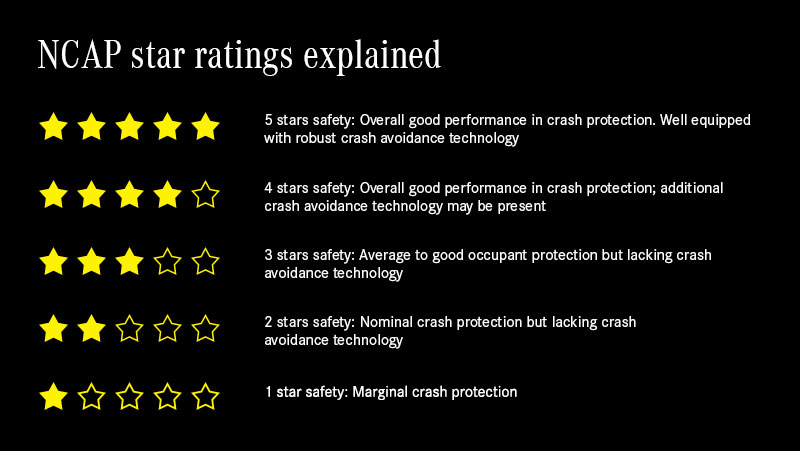We use cookies to make your experience better. To comply with the new e-Privacy directive, we need to ask for your consent to set the cookies. Learn more.


Five star safety rating for the three-pointed star
More stars, more safety.
The tests and rating criteria are in a constant state of refinement in order to account for technological developments and the changing automotive landscape. Comparing vehicle ratings year on year can therefore be problematic because models could be exposed to divergent test procedures. However, the test accurately reflects the performance of the vehicle in the environment in which it was released. The current star ratings are detailed below:
Driving development.
The rating system goes beyond legal requirements with the aim of encouraging greater investment into research. For instance, a vehicle that just meets legal requirements would not be eligible to receive any stars at all. This is because the function of Euro NCAP hasn’t solely been to measure crash safety performance for consumer insight but to motivate manufacturers to push the science forward and consequently save lives. Now celebrating its 20th anniversary, Euro NCAP has published 630 safety ratings, has crash tested over 1,800 cars, and has saved an estimated 78,000 lives as a result. Definitively, over 160 million Euros has collectively been spent on making vehicles safer.A defining ideology.
Making top-class safety available to everyone is the declared aim of Mercedes-Benz. As the home of the anti-lock braking system (1978) and the driver airbag (1981), amongst many more, Mercedes-Benz is proud to play a leading role in the field of automotive safety. "We will continue to intensify our efforts... so as to provide the best possible safety not only for drivers and passengers in a Mercedes-Benz, but also for more vulnerable road users such as pedestrians and cyclists." explains Prof. Dr. Ing. Rodolfo Schöneburg, Head of Vehicle Safety, Durability and Corrosion Protection at Mercedes-Benz Cars. All Mercedes-Benz models are designed with real-world accidents in mind. The focus is on avoiding collisions altogether but, where not possible, this reverts to mitigating the consequences for all involved. The significance of this defining ideology is reflected in the NCAP ratings of Mercedes-Benz vehicles - which consistently score the full five stars.2014 - The Mercedes-Benz C-Class.
The C-Class was awarded best in its class when tested in 2014. Of all others assessed in the 'Large Family Car' category, the C-Class achieved the highest combined score. Also in 2014, the Mercedes-Benz GLA and the V-Class were awarded five stars.
2015 - The Mercedes-Benz GLC.
A second class-leading achievement came in 2015 when the GLC performed best of all others in the 'Small Off-Road' segment. Of particular reference was the GLC's active bonnet. When sensors on the bonnet detect impact, the bonnet is raised by 80mm to provide additional deformation space between the subject and the hard contents in the engine compartment.
2016 - The Mercedes-Benz E-Class.
The most recent model to be tested was the E-Class Saloon. Once again, it achieved the highest possible safety rating - attributed to its high-strength safety cell, highly effective restraint systems and a the large number of driver assistance systems on board.
